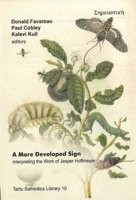Sensemaking
Sensemaking
Author(s): Theresa S. S. SchilhabSubject(s): Language and Literature Studies, Semiotics / Semiology
Published by: Tartu Ülikooli Kirjastus
Summary/Abstract: What does it mean, as Hoffmeyer points out, that there never occurs a regularity or a habit in nature that has not become a sign for some other organism or species? Relating individual signs to the processes of individual organisms or species in a one-to-one correspondence – as in the case of the sensitivity of the active site in the bacterium E. coli to carbohydrates – describes how life makes sense of the world. However, the claim that the habits of nature are signs also seems to make sense at a more detailed individual level. Clearly, we can conceive of organisms as assemblies of one-to-one correspondences of regularities and responses that have individually evolved, but these thoughts are often constrained by the consideration of the overall functioning of the individual. Thus, the case of our cognitive processes easily comes to mind.
Journal: Tartu Semiotics Library
- Issue Year: 2012
- Issue No: 10
- Page Range: 255-257
- Page Count: 3
- Language: English
- Content File-PDF

